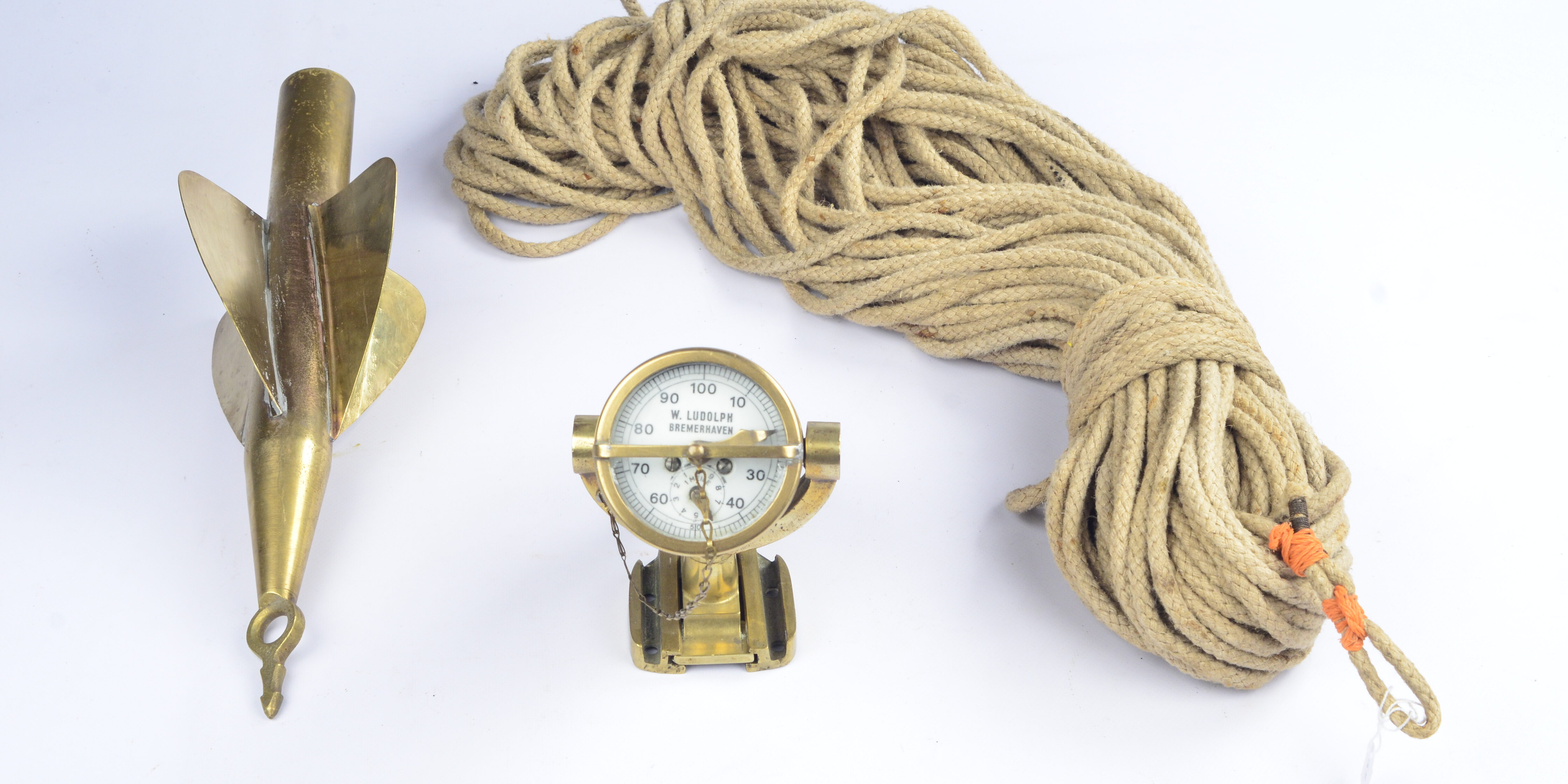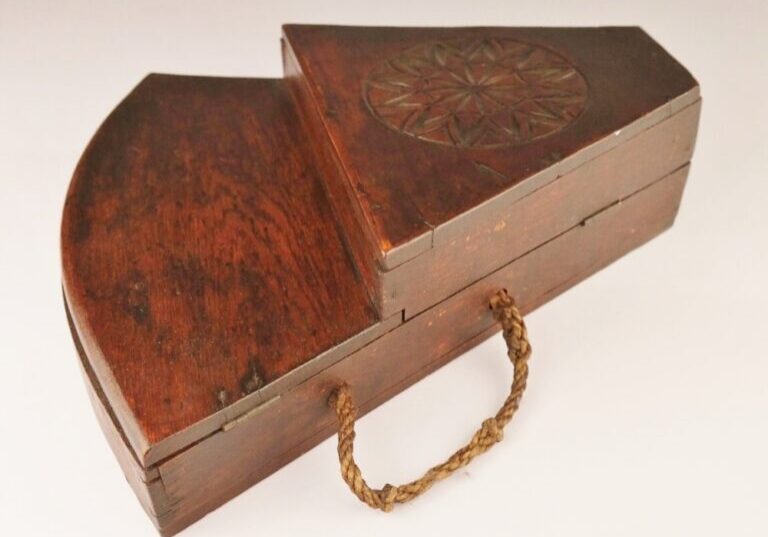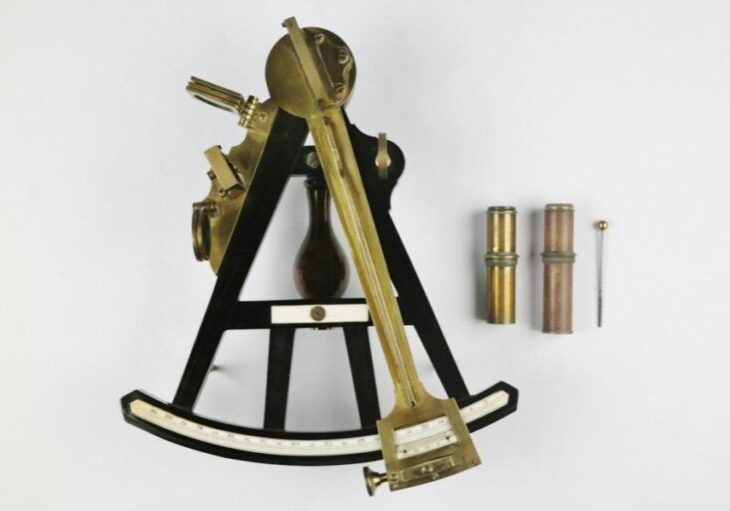Nautical instruments
This part of the collection includes mainly navigational instruments from the early sailing period, the time when ships were made of wood and men were made of steel.
Well preserved whalingcompass with attractive 32-point rose. The rose carries the name of the maker. On the rose, north with fleur de lis. The inside of the binnacle is painted dirty white with lubber’s line. The inside of the lidis marked with 440.
Catalog: NM.2-15
Date: 1800-1830
H: 11 cm (4,3”)
D binnacle: 14 cm (5 4/8”)
Signed: F.J. KLOOS. * ROTTERDAM. *
Origin: Netherlands
Condition: perfect
A foghorn for sailing-vessels was used in foggy wether to pinpoint the ship and to indicate how the vessel is sailing. One blast, when sailing on starboard tack. Two blasts, when sailing on port tack. Three dots, when with wind abaft the beam.
The dovetailed, pine case is painted red with stenciled Norwegian Pattern, operating instructions, original leather strap, brass side crank and copper trumped horn.
Catalog: NM.1-07
Date: late 19th century
HWL case: 38x59x20cm (15×23,2×7,9”)
Origin: England
Condition: perfect, in working condition, wear consistent with age and use
Very fine and complete Navy sextant of black painted brass. Mahony case with dovetailes, lock and little key, brass carrying handle an so on. The inside has a baized-covered lid and bottom. The case is marked with the number 442.
Silvered scale, graduated from -5 to 153 degrees, set in a brass arc. The scale of the sextant is marked with S on the left side and with D 442 on the right side.
Numbering of the case is similar to he numbering of the US Navy sextantcases.
Serialnumber of the sextant is similar to the way of numbering by Brandis and Sons in Brooklyn.
Catalog: NM.1-05
Date: 1900-1920
HWL case: 12,5×27,5×27 cm (4,9×10,8×10,7”)
HW sextant: 21,5×23,3 cm (8,5×9,2”)
Signed: not signed
Origin: USA
Condition: perfect and complete with some few signs of corrosion
Liquid compass in brass binnacle with handle and battery lightning. In wooden case of mahoney.
Made by E. Vion, 38 Rue de Turenne, Paris after 1922.
On top of the compass an adjustable prism with back-side. The inside of the bowl is painted white with dread and lubber’s line.
Catalog: NM.1-03
Date: 1920-1940
HWL case: 32x16x15 cm (12,6×6,3×5,9”)
HD compass: 25×11 cm (9,8×4,3”)
Signed: MINISTÈRE DE LA SANTE PUBLIQUE, E. VION PARIS
Origin: France
Condition: good, mirror weather-beaten
Well preserved pocketcompass in elegant brass box. The carton rose is hand made with 32 points in different colors. At the botom the original rose of about 1850 with the main directions and the name of the maker. In the lid a fixed compass rose with the compass indications and also the name of the maker.
Catalog: NM.2-23
Date: ca. 1850
HD case: 2×7 cm (0,82,8 in)
Signed: Springer Maker Bristol
Origin: England
Condition: perfect
Very fine octant made of ebony and brass. With three mirrors, three colored horizon glass shades, double peepsight and ivory pencilholder. On the backside three brass legs, the adjusing-screws and an ivory slate for making notices.
This instrument is made around 1800, but is a modern instrument in a state of transition. Mention the old fashion way of adjusting the horizon mirror for back sight and the ‘modern’ way of adjusting the other horizon mirror.
Scale of ivory reads from minus 2 to 98 degrees, nice engraved by hand.
The upper peepsigth has two holes and a shutter, the lower one only one hole. The central hole is for direct observation of the sun, the other one, just outside the path of rays, could be used in stead of the sunshades to weaken the sunligth.
The lower horizon mirror and peepsight were used for backward observation. As the horizon just below the sun was invisible, in this way it was possible to use the opposite horizon. The instrument was used back to front. The observer had the sun in his back. The sunshades moved to the lower position.
Originally instrument and box don’t belong together. At some moment, octant and box are adjusted to each other.
Catalog: NM.2-27
Date: 1790-1810
HW octant: 35×28 cm (13.6×11 in)
Radius (rotation axis till nonius): 29 cm (11.3 in)
Signed: J. FOSTER : MAKR : LIVERPOOL
Chest: LARMOUR & Co. BALTIMORE
Origin: England
Condition: a small part of the ivory nonius is missing, nice patin
Gimbaled dry card compass in brass bowl. On the rose the name of the maker.
With wooden case of pine with dovetails and sliding cover. The inside of the bowl is painted white with lubber’s line. On the glass a brass pivot for an azimuthring.
Catalog: NM.1-01
Date: 1880 – 1900
HWL case: 15x23x23 cm (5 7/8×9 1/8x9n 1/8”)
D compass: 15,6 cm (6 1/8”)
Signed: J.B. BRIAND, NANTES. + Fab. de Compas Instrum.ts de Marine +
Origin: France
Condition: perfect, minor repairs on the case
Very fine octant of ebony in original stair stepped case of oak with lock and little key. The inset scale of ivory reads from 0 to 105 degrees, nice engraved by hand. This octant is identical to the octants sold by D. McGregor in Glasgow.
Catalog: NM.1-22
Date: 1820-1850
HWL case: 13×33,8×31,2 cm (5,1×13,3×12,3 in)
HW octant: 30,5×25,5 cm (12×9,8 in)
Radius (rotation axis till nonius): 24,5 cm (9,5 in)
Signed: not signed, probably D. McGregor, Glasgow
Origin: England
Condition: perfect and complete, minor repair on the bottom of the case
Ship-log with tafrailshoe, rope and propellor, made of brass with enamel dial. The milometer on the scale messures up to 100 miles. Details and design features suggest a manufacture date around 1925.
A ship-log records the distance travelled through the water. With the time in hours between the observations, it gives the ship’s speed in knots.
Fixed on the rail at the stern of a ship, the taffrail. The recorder would have been connected with a line to the spinner and the flywheel at the end of the line.
Catalog: NM.1-44
Date: ca. 1925
LD clock: 15×8,3 cm (6,5×5,3 in)
Signed: W. LUDOLPH BREMERHAVEN
Number: 39112
Origin: Germany
Condition: perfect and complete










